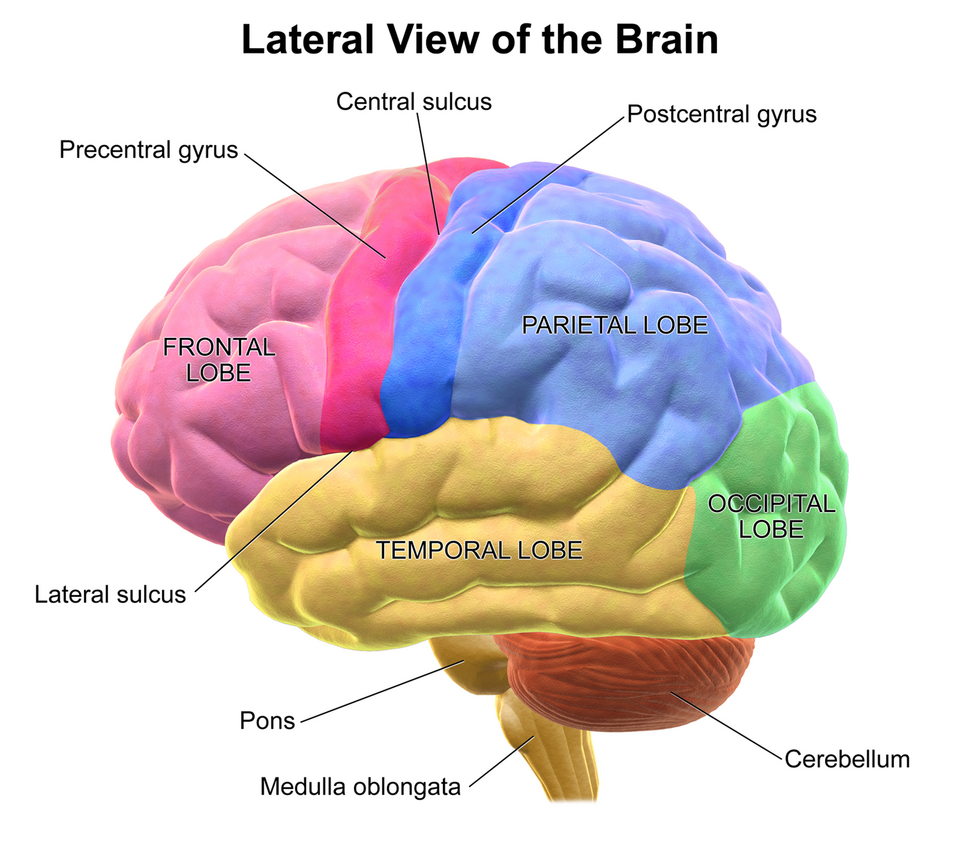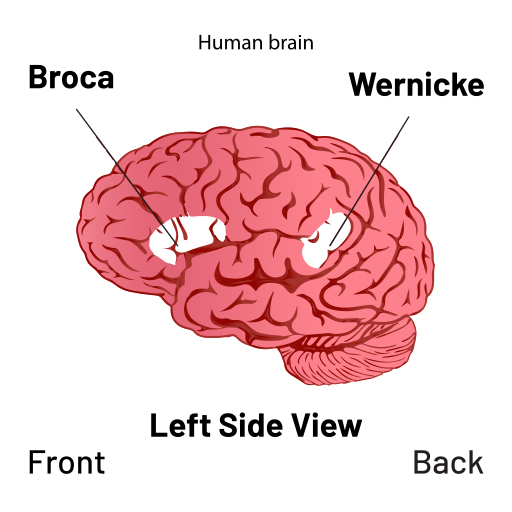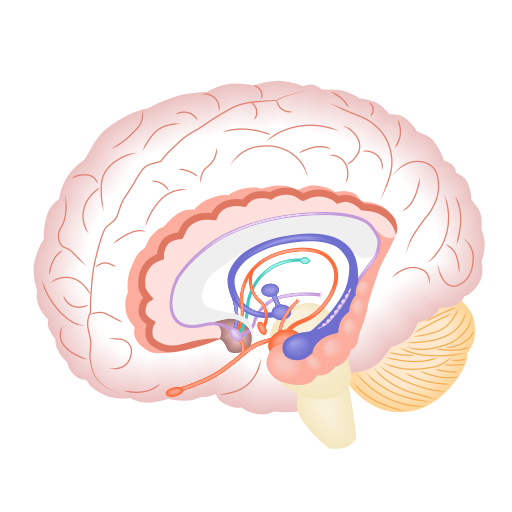IB Syllabus focus:
'- Overview of key regions: Frontal lobe, Parietal lobe, etc.
- Functions associated with each region
- Case studies related to brain damage'
The human brain, an intricately woven tapestry of billions of neurons, is the hub of cognition, emotion, and behaviour. By delving into its architecture, one can glean insights into the neural symphony that plays out in our daily actions and thoughts. Here, we take a deeper look into some of the brain's core regions, their associated functions, and illustrative case studies related to brain damage. This exploration is enhanced by understanding the principles of localisation of function and neuroplasticity, which highlight the specialised roles of different brain areas and their ability to adapt, respectively.

This lateral view labels the frontal, parietal, temporal, and occipital lobes, along with the cerebellum, providing a visual scaffold for understanding each region’s core functions described in the text. Note that fine-grained subregions (e.g., Brodmann areas) are not shown, keeping the diagram focused on IB-level essentials. Source.
Frontal Lobe
Found at the front-most region of the cerebral cortex, the frontal lobe is an essential player in the realm of cognitive abilities and motor function.
Functions:
Reasoning & Decision Making: Critical thinking, planning ahead, and making judgments.
Motor Skills: Initiating voluntary movements through the primary motor cortex.
Speech Production: Broca's area, situated here, is vital for language articulation.
Emotion & Personality: Involved in the expression of emotions and shaping personality traits.
Case Study: Phineas Gage – A railway worker in the 19th century, Gage's frontal lobe was severely injured by an iron rod. Astonishingly, he survived but his once amiable character transformed dramatically, shedding light on the frontal lobe's role in personality modulation. This case also underscores the ethical considerations in animal studies and human research, highlighting the need for compassion and ethical oversight.
Parietal Lobe
Strategically positioned atop the brain, the parietal lobe is a sensory processing powerhouse, especially for spatial information and navigation.
Functions:
Sensory Integration: Processes sensory information like touch and temperature.
Spatial Orientation: Helps in determining objects' positions in space and in relation to ourselves.
Arithmetic: The angular gyrus, located here, plays a role in number processing.
Language Processing: Assists in understanding spoken and written language.
Case Study: Individuals with damage to their right parietal lobe often overlook things on their left (a phenomenon called 'unilateral neglect'). This offers compelling evidence of the lobe's significance in spatial cognition.
Understanding the synaptic transmission process can further illuminate how sensory information is relayed and processed within the parietal lobe.
Temporal Lobe
Situated near the bottom of the brain, the temporal lobe holds the reins to auditory processing and is crucial for memory and language.
Functions:
Auditory Processing: Recognising and processing sounds via the primary auditory cortex.
Memory: The hippocampus, vital for long-term memory consolidation, resides here.
Language Comprehension: Wernicke's area, essential for understanding language, is found here.

This schematic highlights Broca’s area in the frontal lobe and Wernicke’s area in the temporal lobe—key nodes for speech production and comprehension linked by white-matter pathways. The figure adds spatial context to the corresponding functions discussed in the frontal and temporal lobe sections. Source.
Face Recognition: This region is also involved in distinguishing familiar faces.
Case Study: H.M. – To treat his debilitating epilepsy, H.M. underwent a surgery that removed parts of his temporal lobe. Post-surgery, he could no longer form new memories, underscoring the temporal lobe's role in memory processing.
Research into oxytocin's role provides insight into how this hormone influences social recognition and bonding, areas closely tied to the temporal lobe's functions.
Occipital Lobe
At the back of the brain lies the occipital lobe, our primary visual processing centre.
Functions:
Visual Processing: Interprets visual information relayed from the eyes.
Colour Recognition: Identifies different colours and shades.
Depth and Spatial Perception: Assesses distances and spatial relationships in our environment.
Case Study: Patients with injuries to the occipital lobe might suffer from visual agnosia, a condition where one can't recognise familiar objects, even though their vision is functionally intact.
Cerebellum
Tucked underneath the cerebral hemispheres, the cerebellum is instrumental for balance and fine-tuning motor actions.
Functions:
Coordination: Regulates precise, coordinated movements.
Balance: Maintains equilibrium and posture.
Motor Learning: Assists in learning new motor tasks, like riding a bicycle.
Case Study: Alcohol's inebriating effects can impair cerebellar function, leading to unsteady gaits and clumsiness, showcasing its centrality in coordination.
Brain Stem
Acting as a relay centre connecting the cerebrum and cerebellum to the spinal cord, the brain stem ensures the smooth functioning of autonomic processes.
Functions:
Life-Sustaining Functions: Oversees breathing, heart rate, and blood pressure.
Sleep-Wake Cycle: Regulates our natural circadian rhythm.
Reflexes: Manages involuntary reflexes like coughing and sneezing.
Case Study: Damage to the brain stem can be lethal due to its control over fundamental life processes. Even minimal injuries can cause profound disabilities, including paralysis or loss of involuntary functions.
Limbic System
This complex network of structures nestled deep within the brain holds the keys to our emotions, motivations, and memories.

This diagram locates major limbic components (e.g., hippocampus and amygdala) that underlie emotion regulation and memory; some panels may include additional nuclei beyond the IB core, which you can treat as enrichment. Source
Functions:
Emotion Regulation: The amygdala, a part of the limbic system, modulates emotional responses.
Memory Formation: The hippocampus aids in forming and organising memories.
Drive & Pleasure: The nucleus accumbens plays a role in motivation, pleasure, and addiction.
Case Study: Clive Wearing endured a viral infection that ravaged his limbic system. While his intellectual abilities remained unscathed, he became trapped in an endless present, unable to forge new memories or recall past ones.
The intricate interplay of these regions orchestrates the multitude of tasks we undertake daily. As the curtain lifts on these neural underpinnings, we gain profound insights into the essence of human nature, behaviour, and cognition. Such knowledge not only satiates our academic curiosities but also holds the potential to revolutionise therapeutic interventions and treatments in the realm of psychology.
FAQ
The brain stem is paramount for basic vital life functions. If it were damaged, the consequences could be severe or even fatal. It controls fundamental processes such as breathing, heart rate, and blood pressure. Additionally, it plays a role in the sleep-wake cycle and manages involuntary reflexes like swallowing and blinking. Damage to the brain stem can lead to a myriad of issues, ranging from breathing difficulties and irregular heart rhythms to complete loss of consciousness or coma. Due to its role in basic life-sustaining functions, even minor injuries can have profound implications, and significant damage might necessitate life-support interventions.
The occipital lobe is the brain's primary visual processing centre. When visual stimuli enter the eyes, they pass through the retina and are relayed to the brain via the optic nerves. At the optic chiasm, the nerve fibres from the medial (inner) half of each eye cross over, ensuring that information from the left visual field (from both eyes) is processed in the right occipital lobe, and vice versa. This setup allows for binocular vision and depth perception. Within the occipital lobe, the primary visual cortex processes these stimuli, interpreting attributes like colour, shape, and movement to create our visual experience.
The limbic system, a complex network of structures deep within the brain, is integral to our emotional experiences. Key components like the amygdala, hippocampus, and hypothalamus play pivotal roles. The amygdala, for instance, modulates our reactions to fear and pleasure and is involved in determining the emotional significance of stimuli and events. The hippocampus, while primarily associated with memory, interacts with the amygdala in forming emotionally charged memories. The hypothalamus links the nervous system to the endocrine system, thereby influencing emotional responses through hormone release. Collectively, these interconnected structures work in harmony to shape our emotions, moods, and feelings in response to our experiences.
Broca's area and Wernicke's area are two distinct regions in the brain crucial for language processing, and they collaborate closely. Broca's area, located in the frontal lobe, is primarily responsible for language production and articulation. In contrast, Wernicke's area, situated in the temporal lobe, is crucial for language comprehension. These two areas are connected by a bundle of nerve fibres called the arcuate fasciculus. If one imagines a conversation, Wernicke's area helps in understanding what is being said, while Broca's area assists in formulating an appropriate response. Damage to either region can result in specific types of aphasia: Broca's aphasia leads to halting speech but retained comprehension, while Wernicke's aphasia results in fluent but nonsensical speech.
The cerebellum, derived from Latin meaning "little brain", earns its epithet due to its appearance and positioning. It's a smaller, separate structure tucked under the cerebral hemispheres, with a unique, tightly folded surface that gives it a compact appearance. Despite its diminutive size relative to the cerebrum, the cerebellum is packed with more neurons and is instrumental in coordinating and fine-tuning motor actions, maintaining balance, and ensuring that movements are precise and smooth. Its significance in motor control means that damage to this area can lead to coordination issues, tremors, and problems with posture and gait.
Practice Questions
The frontal lobe is pivotal in shaping our personality traits and influencing our emotions. A salient case study underpinning this is Phineas Gage, a 19th-century railway worker. After an accident in which an iron rod impaled his frontal lobe, Gage survived but underwent a drastic personality transformation. Once congenial and responsible, post-accident Gage became impulsive and erratic, showcasing a marked change in personal traits. This transformation spotlighted the frontal lobe's indispensable role in modulating personality and influencing our behavioural responses.
The temporal lobe, particularly the hippocampus residing within it, is crucial for consolidating long-term memories. A stark illustration of this function is provided by the case of H.M., a patient who had portions of his temporal lobe removed to treat epilepsy. Post-surgery, H.M. displayed a severe anterograde amnesia – while he retained older memories, he was incapable of forming new long-term ones. This inability to create new memories after the surgical intervention emphasises the fundamental role the temporal lobe, especially the hippocampus, plays in memory processing and storage in the human brain.

